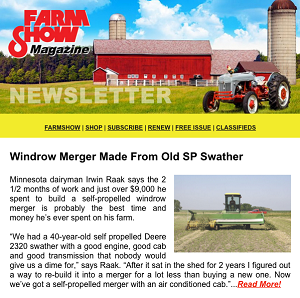Arched-Roof Workshop
Del Stubbs hopes he inspires others to bring the Gothic arch roof back. A couple of years ago he built one for his two-story 26 by 50-ft. workshop, and he loves the clear span, open space and strength the design provides. He and his carpenter friend, Michael Peterson, made the arched rafters out of two units of 16-ft. 1 by 8 No. 2 pine boards, lots of 1 3/4-in. staples and nearly 50 lbs. of glue.
“The arches were fairly quick to build, and the material cost wasn’t bad,” says Stubbs, noting he wouldn’t have done it without Peterson. They rigged up a jig to cut a 16-ft. radius arc by building a cradle that pivots on a lag screw secured to a wall. The cradle sweeps the boards through a table saw. He used an old carbon steel ripping blade and added a bit of set to the teeth for kerf clearance. The cut pieces are reversed, glued, and air nailed together to make a curved board. Using various length boards to stagger the joints, Stubbs and Peterson connected and bonded three layers of boards and plywood gussets to create each rafter.
“Unlike a Quonset that is flat on top, we tapered 2 by 4’s so I have a 6/12 pitch at the peak. I believe that is where the ‘Gothic’ name comes in,” Stubbs says. He and Peterson nailed the tapered 2 by 4’s together into a rib-like assembly to create the peak’s pitch.
After covering the rafters (2-ft. centers) with 1/2-in. plywood sheathing, 2-in. foam insulation, tar paper and 1 by 4 blocking, they finished the roof with steel sheets installed horizontally.
“This unusual roofing, called ‘Grand Beam’ is made for tight radius arched roofs, and, unlike most roofing, the peak piece goes on first,” Stubbs explains.
The cost of the roof would have been competitive with regular rafters, Stubbs says, if he hadn’t added six dormer windows that needed to be custom made for the curvature in the roof.
Stubbs wanted the natural lighting for the second story, which is used for storage and the finish work on the Scandinavian wood carving tools and supplies he makes. After working out of a 12 by 24-ft. shed for many years, he appreciates the light and design of the new shop. He and Peterson sheetrocked the ceiling with 1/2-in. extra-strength, ceiling drywall sheets, which easily conformed to the curve. They used dense packed cellulose for the walls and roof insulation.
“The arched barn was a common building style here in northern Minnesota during the early 1900’s,” Stubbs says. “The free span space is a huge plus in a workshop as well.”
He encourages people to consider building the arch roof style. He posted photos and short videos of the process at https://tinyurl.com/2cq6568.
Contact: FARM SHOW Followup, Del Stubbs, Leonard, Minn. 56652 (ph 218 243-2145;
[email protected]).

Click here to download page story appeared in.
Click here to read entire issue
Arched-Roof Workshop BUILDINGS Miscellaneous Del Stubbs hopes he inspires others to bring the Gothic arch roof back A couple of years ago he built one for his two-story 26 by 50-ft workshop and he loves the clear span open space and strength the design provides He and his carpenter friend Michael Peterson made the arched rafters out of two units of 16-ft 1 by 8 No 2 pine boards lots of 1 3/4-in staples and nearly 50 lbs of glue “The arches were fairly quick to build and the material cost wasn’t bad ” says Stubbs noting he wouldn’t have done it without Peterson They rigged up a jig to cut a 16-ft radius arc by building a cradle that pivots on a lag screw secured to a wall The cradle sweeps the boards through a table saw He used an old carbon steel ripping blade and added a bit of set to the teeth for kerf clearance The cut pieces are reversed glued and air nailed together to make a curved board Using various length boards to stagger the joints Stubbs and Peterson connected and bonded three layers of boards and plywood gussets to create each rafter “Unlike a Quonset that is flat on top we tapered 2 by 4’s so I have a 6/12 pitch at the peak I believe that is where the ‘Gothic’ name comes in ” Stubbs says He and Peterson nailed the tapered 2 by 4’s together into a rib-like assembly to create the peak’s pitch After covering the rafters 2-ft centers with 1/2-in plywood sheathing 2-in foam insulation tar paper and 1 by 4 blocking they finished the roof with steel sheets installed horizontally “This unusual roofing called ‘Grand Beam’ is made for tight radius arched roofs and unlike most roofing the peak piece goes on first ” Stubbs explains The cost of the roof would have been competitive with regular rafters Stubbs says if he hadn’t added six dormer windows that needed to be custom made for the curvature in the roof Stubbs wanted the natural lighting for the second story which is used for storage and the finish work on the Scandinavian wood carving tools and supplies he makes After working out of a 12 by 24-ft shed for many years he appreciates the light and design of the new shop He and Peterson sheetrocked the ceiling with 1/2-in extra-strength ceiling drywall sheets which easily conformed to the curve They used dense packed cellulose for the walls and roof insulation “The arched barn was a common building style here in northern Minnesota during the early 1900’s ” Stubbs says “The free span space is a huge plus in a workshop as well ” He encourages people to consider building the arch roof style He posted photos and short videos of the process at https://tinyurl com/2cq6568 Contact: FARM SHOW Followup Del Stubbs Leonard Minn 56652 ph 218 243-2145; mdstubbs@paulbunyan net
To read the rest of this story, download this issue below or click
here to register with your account number.








